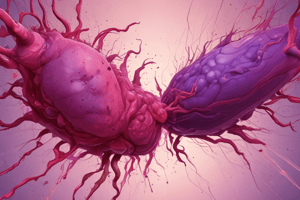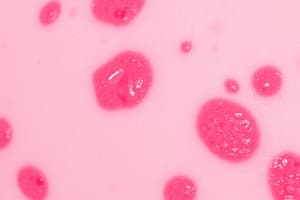Podcast
Questions and Answers
What is the primary cause of Purpura Fulminans?
What is the primary cause of Purpura Fulminans?
What is the result of hypergammaglobulinemia in Hyperviscosity Syndrome?
What is the result of hypergammaglobulinemia in Hyperviscosity Syndrome?
What is a characteristic skin lesion of Purpura Fulminans?
What is a characteristic skin lesion of Purpura Fulminans?
What is the major initiating factor of Purpura Fulminans?
What is the major initiating factor of Purpura Fulminans?
Signup and view all the answers
What is a complication of Purpura Fulminans?
What is a complication of Purpura Fulminans?
Signup and view all the answers
What is the term for rapid onset of purpura?
What is the term for rapid onset of purpura?
Signup and view all the answers
What is the result of production of cryoprecipitate?
What is the result of production of cryoprecipitate?
Signup and view all the answers
What is a characteristic of Hyperviscosity Syndrome?
What is a characteristic of Hyperviscosity Syndrome?
Signup and view all the answers
What is a complication of intravascular coagulation?
What is a complication of intravascular coagulation?
Signup and view all the answers
What is associated with primary plasma cell dyscrasias?
What is associated with primary plasma cell dyscrasias?
Signup and view all the answers
What is a characteristic of Purpura Fulminans?
What is a characteristic of Purpura Fulminans?
Signup and view all the answers
Study Notes
Purpura
- Petechiae can be seen on the thighs
- Can be caused by anemia and low ascorbic acid level, treated with ascorbic acid administration
Types of Purpura
- Purpura of Unknown Origin
- Purpura Simplex (Simple Purpura or Devil's Pinches)
- Caused by skin fragility
- Seen in older individuals or those undergoing corticosteroid therapy
- Bleeding is superficial
- Senile Purpura
- Seen in older individuals or those undergoing corticosteroid therapy
- Purpuric lesions/bruises occur on the hands and arms
- Drug-Induced Purpura
- Caused by iodides, quinine, procaine, penicillin, and aspirin
- Psychogenic Purpura
- Seen in individuals with emotional problems, often after severe trauma or extensive surgery
- Hypersensitive to RBC membrane components or DNA hypersensitivity
- Scurvy
- Caused by a deficiency in Vitamin C (ascorbic acid)
- Decreased synthesis of collagen with weakening of capillary walls
- Commonly seen in children; renal dysfunction is common and typically reversible in children
Acquired Vascular Disorders
- Caused by external/environmental problems
- Examples include:
- Infections (e.g., Rickettsia, viruses, cocci)
- Septic emboli to the skin (Ecthyma gangrenosum) in endocarditis
Allergic Purpuras
- Anaphylactic Purpura
- Characterized by a relatively distinctive purpuric eruption with constitutional and localized symptoms
- Nonthrombocytopenic Purpura
- Characterized by allergic manifestations - skin rash and edema
- Associated with certain foods, drugs, cold, and insect bites
- Caused by autoimmune process or allergic vasculitis
Purpura Fulminans
- Characterized by sudden onset, fever, prostration, symmetric circumscribed ecchymoses, and infarcts of the skin and frequently gangrene of the extremities
- Caused by diffuse vascular injury and intravascular coagulation
- Can be seen in any purpura with rapid onset
Hyperviscosity Syndrome
- Results from hypergammaglobulinemia
- Caused by an increase in plasma viscosity
Studying That Suits You
Use AI to generate personalized quizzes and flashcards to suit your learning preferences.
Description
This quiz is about diagnosing and treating petechiae on the thighs, with a focus on laboratory findings and treatment options. It covers anemia, low ascorbic acid levels, and administration of ascorbic acid.




